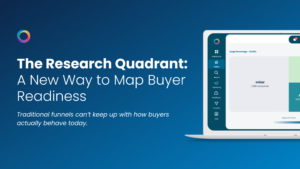
Integrating your sales and marketing team is an integral strategy that every company should adopt in 2019. Potential customers are becoming more and more informed about their options through online research. This means that companies with a divided, fractured approach to sales and marketing could lose out to companies with a unified team that embraces the advantages of both skillsets.
Integrated marketing and sales will not only create a more efficient workforce, but the shared information and goals between the teams will generate better inbound leads and lead to more sales.
Why Integrate Sales and Marketing?
- Sales professionals are usually eager to find and close sales quickly and move on to identifying more opportunities.
- In contrast, marketing professionals often have a long-term approach based on building a quality brand over time.
- The traditional sales model where a salesperson controls the information that a customer receives about a company, product or service is gone.
- Today’s consumers know exactly what they want and have researched the alternatives online.
- This ‘new normal’ means that a new approach to potential customers is needed. One that nurtures leads through marketing and ensures they are more prepared before speaking to a salesperson.
An Integrated Approach
An approach that integrates sales and marketing is vital for businesses today. It allows the two groups to inform each other rather than disagree and creates visible, tangible goals that both teams work towards.
Regular and open communication between the two groups can make them realise that their similarities are greater than their differences. This can help them create a combined, complementary strategy that is focused on a single objective – generating quality leads and revenue for the company.
How to Integrate Sales and Marketing
- Find shared goals revenue generation, accountability, targets
- Create specialised personas, content triggers and touchpoints
- Improve analysis, development
Definitions
Lead Scoring is a numerical measure of how ‘hot’ or ‘cold’ a lead is. It allows leads to be ranked according to how close they appear to be to buying.
- A Marketing Qualified Lead (MQL) is someone that has achieved a certain lead score and is ready to be handed from the Marketing team to the Sales team.
- A Sales Accepted Lead (SAL) is a lead that the Sales team have committed to contact through a number of follow-up actions.
- A Sales Qualified Lead (SQL) are leads that convert into opportunities. They result in either a Sale, a Loss, or may be considered for further Sales attempts in the future.
An Approach Based on Reciprocation
- The sales team will find that leads generated through inbound marketing – people who have already expressed an interest in the company – are easier to close. • This should motivate the sales team to have more input into the marketing process.
- This involves providing extensive feedback from existing customers, or from unsuccessful leads, that can improve future marketing campaigns. They must also take responsibility for how MQL leads are managed in general.
- At the same time every marketing activity should be tied to a sales objective. The marketing team’s main focus should not be on building the company’s image in general, but on delivering quality, brand- aware leads to the Sales team.
Accountability
There must be a clear agreement between Sales and Marketing about their responsibilities and expectations. Each team should accept responsibility for how leads are handled in every circumstance and be willing to be flexible in unusual situations.
There should be a discussion around:
- How soon after Marketing pass a qualified lead on to sales, will the lead be contacted?
- What Marketing materials and content are certain types of lead most interested in?
- Which leads who are currently interested in buying will be the subject of future Marketing efforts and what form could this take?
- When to take stock of the combined approach and make changes based on experience?
Targets – Create a Service Level Agreement
- Setting a Service Level Agreement (SLA) between the two teams based on generating revenue can help focus their efforts.
- Time should be set aside at regular intervals to re-evaluate the SLA. As your business strategy and targets evolve, your SLA will need to adapt.
- As the number of MQLs generated increases, there needs to be discussions of how much time is spent on them in relation to leads generated by the Sales team.
- If it becomes particularly time-consuming for the Sales team to follow up on every MQL, it may prove useful to automate some follow-ups (e.g. send a standard email) to reduce their workload.
Targets Assign a Value to Every Lead
There is no better way to demonstrate the value of marketing campaigns and to set future targets than to assign a cash value to every lead generated. You can work out the value of each lead generated by looking at the cost and level of engagement of the marketing campaign that attracted their interest.
Create Specialised Personas
Get the sales and marketing teams together to brainstorm the type of leads they are currently dealing with and also the type of customer they would ideally like to target. They should consider how and why people buy the company’s products and services and how they can guide them through this process better. Try to identify four key personas that you’d like to target as a business and consider how they may be approached at different stages of the buying process.
The Buying Proces
- Awareness – Can You Help Me?
- Consideration – What Do You Do?
- Interest – What’s Different About You?
- Preference – Are You The Best Value For Me?
- Purchase – How Much? How Long? And When?
Personas
- Basic Information – Name, industry, market segment, role in company, competitors, your relevant product or service
- Background – Demographics (gender, age, income, education, location, value and goals, personality traits, interests) • About their Role – Job responsibilities, challenges, career objectives, KPI’s
- Quotes – How would this person describe: problems or challenges in their work? Common objectives to buying?
- Sources – Who are your persona’s trusted brands and influencers? What information sources do they use (blogs, social media)?
Specialise Content
Some potential customers may need content which explains the benefits of your product or service in a very basic way, while others may have experience in your industry and may respond better to content that illustrates the advantages your company provides compared to competitors.
- Webinars and eBooks are great ways to provide long, detailed content that is helpful for potential customers.
- FAQs on your website provide convenient answers to common questions that can save a lot of time during the Sales process.
- Videos demonstrating your products and services can also save Salespeople some time and can provide a great introduction to your company in just a few minutes.
- The Sales team should be very up to date when it comes to the latest marketing materials, as this will help them adopt a more detailed approach to the particular issues of a potential customer.
Triggers and Touchpoints
- There will be initial content which will attract interest and explain what products and services your company provides.
- The next step is to think about actions that a lead can take that would trigger a certain response from the Sales and Marketing team.
- As the strategy around triggers develops, it is something that would benefit greatly from automation, freeing up time for sales and marketing while leads continue to be nurtured.
Multichannel Approach
Using a multichannel approach, you should decide on a different approach to someone who has read your website and blog, attended a webinar and followed your social media than someone who has responded to a single email. The sales and marketing strategy should also adapt to what appear to be the preferred channels that potential customers use to communicate with the business.
Develop Content for Each Stage of the Funnel
Top of the funnel
- Awareness: Focus on being helpful, competent and a valuable member of your audience’s community
- Interest: Focus on nurturing a relationship, gradually scaling touchpoints on social media and via email
Middle of the funnel
- Intent: Focus on case studies, webinars and collateral that’s closely married to a value proposition
- Decision: Focus on sales team involvement to close an MQL and alternate messaging
Bottom of the funnel
- Intent: Focus on case studies, webinars and collateral that’s closely married to a value proposition
- Decision: Focus on sales team involvement to close an MQL and alternate messaging
Improve analytics
Through analytics you’ll see how well your Marketing leads are performing and be able to make changes. If conversions are high, you should lower the Lead Score and send more leads to the Sales team. If conversions are too low, then you should consider changing the criteria for scoring leads.
- Evaluate your strategy’s performance across the entire Sales funnel. You may find opportunities that can increase conversion rates or lower your lead acquisition costs.
- The Sales team should work with Marketing to ensure that unsuccessful leads are recycled back up the funnel as a target for further campaigns.
- They should also work to convert acquired sales leads into satisfied and loyal customers who are also ready to buy again at the next sales opportunity.
Improve Development
As the integrated strategy continues to evolve, opportunities to develop the capabilities of both the Sales and Marketing team should also be considered. This could take the form of training that can benefit both teams and help them understand each other’s points of view. Or tools that enable better communication and reporting between the two teams. A marketing automation platform such as Zymplify that can create, track and compare campaigns would be a massive benefit to an integrated sales and marketing team.
More from Zymplify
Top Inbound Marketing Tools to use in 2019
Inbound Marketing and Marketing Automation
The Power of Inbound Marketing: Are You Really Using it Effectively?



